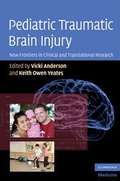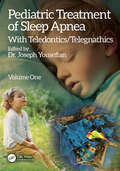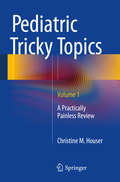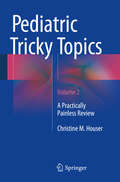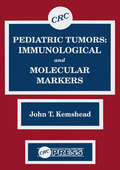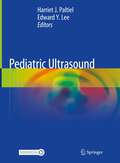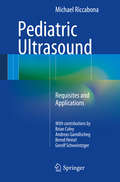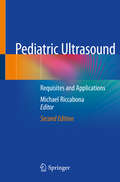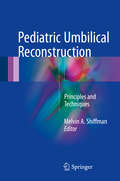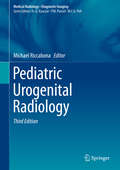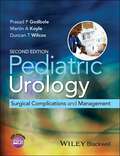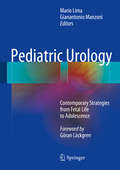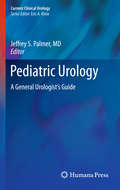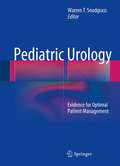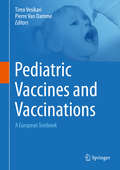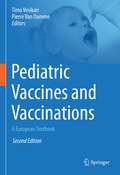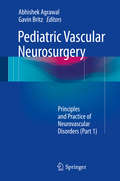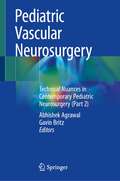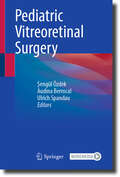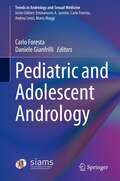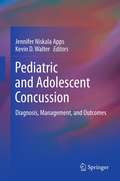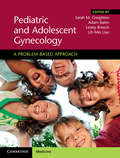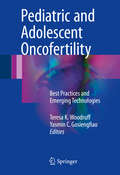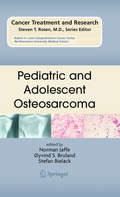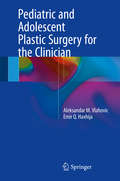- Table View
- List View
Pediatric Traumatic Brain Injury
by Vicki Anderson Keith Owen YeatesTraumatic brain injury (TBI) is a leading cause of death and disability in children and adolescents Worldwide and represents a largely "silent" public health epidemic. Advances in acute medical care have resulted in better survival rates, but long-term quality of life remains of ongoing concern. The cognitive, emotional and behavioral consequences of TBI frequently pose life long problems for these children and their families leading to substantial economic and societal costs.
Pediatric Treatment of Sleep Apnea: With Teledontics/Telegnathics
by Joseph YousefianThis first of two volumes presents groundbreaking information on sleep apnea in children and youths. It provides easily comprehensible instruction ideal for students; practicing dental, medical, and allied medical practitioners; and researchers who wish to expand their knowledge base on this critical interdisciplinary topic. The book contains practical and well-documented case examples, which are not theoretical but illustrate common patient problems and effective, unparalleled interdisciplinary treatment strategies.There is a disconnect on how health professions perceive and treat the causes of upper airway conditions. Various comorbidities can result from sleep apnea, oxygen deprivation, and upper airway conditions. This book connects oropharyngeal structure to metabolic disease through the practice of teledontics. Teledontics as a new interdisciplinary integrative medical–dental approach for treatment of obstructive sleep apnea is emerging rapidly. It relates oxygen needs of the body in addition to other nutritional requirements, focusing on how oxygen insufficiency can lead to multiple health comorbidities.
Pediatric Tricky Topics, Volume 1
by Christine M. HouserWith hundreds of question and answer items and bite-sized chunks of information that can be read and processed easily, reviewing for the pediatric board exams - or just brushing up in your spare time - has never been easier. Pediatric Tricky Topics, Volume 1: A Practically Painless Review includes review items in pediatric orthopedics, trauma, environmental medicine, toxicology, rheumatology, and neurology topics, among others. The Q&A format allows for self-testing or study with a partner or a group and is practical and accessible enough to dip into during a few minutes of downtime at the hospital or office, and as such it is suitable for those studying for the pediatric board exam, practicing physicians brushing up their skills, and any busy clinician who wants to learn more about these topics while on the go.
Pediatric Tricky Topics, Volume 2
by Christine M. HouserWith hundreds of question and answer items and bite-sized chunks of information that can be read and processed easily, reviewing for the pediatric board exams - or just brushing up in your spare time - has never been easier. Pediatric Tricky Topics, Volume 2: A Practically Painless Review includes review items in pediatric immunology, hematology, oncology, nephrology, urology, dermatology, ophthalmology, otorhinolaryngology, and gynecology, among others. Selected expanded sections provide more in-depth information, while the Q&A format allows for self-testing or study with a partner or a group and is practical and accessible enough to dip into during a few minutes of downtime at the hospital or office. As such, it is suitable for those studying for the pediatric board exam, practicing physicians brushing up their skills, and any busy medical student, nurse or clinician who wants to learn more about these topics while on the go.
Pediatric Tumors: Immunological and Molecular Markers
by John T. KemsheadThis monograph explains the considerable impact that monoclonal antibodies and molecular probes have had on the diagnosis of tumor types and sub-types. It explains how radiolabelled monoclonal antibodies have also been used as imaging agents to try to improve the oncologist's ability to define residual tumor deposits after combination chemo/radiotherapy. Finally, the childhood malignancies that still have a poor prognosis are presented, and new novel ways of therapy are explained.
Pediatric Ultrasound
by Edward Y. Lee Harriet J. PaltielThis essential book is a unique, authoritative and clinically oriented text on pediatric ultrasound. It provides up-to-date information addressing all aspects of congenital and acquired disorders in children encountered in clinical practice. The easy-to-navigate text is divided into 20 chapters. Each chapter is organized to cover the latest ultrasound techniques, normal development and anatomy, anatomic variants, key clinical presentations, characteristic ultrasound imaging findings, differential diagnoses and relevant pitfalls. With more than 2400 images, examples of new technological developments such as contrast-enhanced ultrasound and elastography are included. Written by internationally known pediatric radiology experts and editorial team lead by acclaimed authors, Harriet J. Paltiel, MDCM and Edward Y. Lee, MD, MPH, this reference is a practical and ideal guide for radiologists, radiology trainees, ultrasound technologists as well as clinicians in other specialties with an interest in pediatric ultrasound.
Pediatric Ultrasound
by Michael RiccabonaUltrasound (US) plays an extremely important role in diagnostic imaging of neonates, infants, and children. This book systematically covers the use of US in all organ systems throughout childhood. After discussion of the basics, including physics, artifacts, and procedural details, decision making regarding the use of US is elucidated by discussing next diagnostic steps based on recommended imaging algorithms. The indications and prerequisites for a particular examination are listed, and practical tips and tricks are highlighted. The normal, age-dependent findings and typical appearances in different pathologies are then presented and illustrated by numerous high-quality images. Particular emphasis is placed on those findings that differ from the adult US appearances. Pediatric Ultrasound will prove an indispensable source of information for radiology residents, experienced (pediatric) radiologists, sonographers, pediatricians, and all other physicians who deal with children in their daily practice.
Pediatric Ultrasound: Requisites and Applications
by Michael RiccabonaThis book, now in a revised and updated second edition, systematically covers the use of ultrasound in all organ systems throughout childhood. After discussing the basics, including physics, ultrasound methods, and artifacts, it elucidates decision-making regarding the use of ultrasound by discussing diagnostic flow charts based on recommended imaging algorithms. The main part of the book addresses ultrasound investigations of the various organs. It documents the indications and prerequisites for specific examinations and offers practical tips and tricks. The normal, age-dependent ultrasound findings and typical appearances in different pathologies are presented in detail and illustrated by numerous high-quality images, with a particular emphasis on those findings that differ from the adult sonographic appearances. And finally, dedicated chapters explore point-of-care and emergency ultrasound, interventional ultrasound, and present orienting tables. This state-of-the-art book covers modern techniques and applications, like contrast-enhanced ultrasound, ultrasound elastography, and automated-image optimization, as well as all pediatric ultrasound applications from point-of-care ultrasound and orienting assessment also at the intensive care unit/emergency room to more detailed and advanced applications, e.g., in dedicated tertiary referral centers. Pediatric Ultrasound is an invaluable source of information and an indispensable aid to decision-making and diagnosis for radiology residents, (pediatric) radiologists, sonographers, pediatricians, (pediatric) surgeons, urologists, and all other physicians who deal with children as a part of their daily practice.
Pediatric Umbilical Reconstruction
by Melvin A. ShiffmanThe book starts with a short introduction to the topic, followed by a detailed description of the anatomical differences between exstrophy and gastroschisis. In the following chapters, the authors describe the surgical umbilicoplasty for congenital defects in children. Outcomes and complications will be discussed in the last chapter. Written by respected authors, this book will offer residents and fellows as well as practicing and highly experienced plastic surgeons essential guidance on treatment and decision-making concerning umbilical reconstruction. Its numerous illustrations and clearly structured content make the book a must-read.
Pediatric Urogenital Radiology (Medical Radiology)
by Michael RiccabonaThis third edition of Pediatric Urogenital Radiology has been thoroughly updated to take account of the recent advances in the imaging and treatment of pediatric nephro-urologic disorders that have been achieved over the past years. A number of new chapters have been included on topics such as the role of ultrasound and MRI for urogenital imaging in the fetus and the use of contrast media in childhood. Other chapters have been extensively revised or rewritten, while information that continues to be pertinent has been retained. The book describes in detail all aspects of pediatric urogenital radiology. It is written primarily from the point of view of the radiologist, but also includes essential clinical information from and for the pediatrician, pediatric surgeon, and urologist. It is specifically designed to aid the clinician in making decisions on imaging management, and to help the radiologist to understand the clinical background and needs. The newest techniques and the changing relevance of imaging and interventional procedures are described, and the diverse problems associated with the changing anatomy, physiology, and pathophysiology from the newborn period to adulthood are explained. The whole spectrum of imaging features of agenesis, anomalies and malformations, dysplasia, parenchymal and cystic diseases, urolithiasis, neoplastic diseases, renal vascular hypertension, renal failure, renal transplantation, pre-and postoperative imaging, and genitourinary trauma is covered. Individual chapters are devoted to vesicoureteric reflux, urinary tract infection, congenital urinary tract dilatation, upper urinary tract dilatation, voiding dysfunction, and neurogenic bladder. A chapter on the clinical management of common nephrourologic disorders explains how imaging is embedded in the whole process of clinical management. Short conclusions are included at the end of chapters and sections to highlight the key information.
Pediatric Urology
by Duncan T. Wilcox Prasad P. Godbole Martin A. KoylePediatric Urology: Surgical Complications and Management,2nd edition focuses 100% on the most common problems that can occur during pediatric urologic surgery, and how best to resolve them, ensuring the best possible outcome for the patient. As well as being thoroughly revised with the latest in management guidelines, brand new to this edition are a host of clinical case studies highlighting real-life problems during urologic surgery and the tips and tricks used by the surgeon to resolve issues faced. These will be invaluable for urology trainees learning their trade as well as for those preparing for Board or other specialty exams. Chapters will include problem solving sections as well as key take-home points. In addition, high-quality teaching videos showing urologic surgery in action will be included via the companion website - again proving an invaluable tool for all those seeking to improve their surgical skills. Edited by an experienced and international trio of urologists, they will recruit the world's leading experts, resulting in a uniform, high-quality and evidence-based approach to the topic. Pediatric Urology: Surgical Complications and Management, 2nd edition is essential reading for all urologists, especially those specialising in pediatric urology and urologic surgery, as well as general surgeons.
Pediatric Urology
by Mario Lima Gianantonio ManzoniThis encompassing volume gathers contributions by renowned experts in the field of pediatric urology to offer a systematic and complete review of the field. The book opens with a general section covering the basis of renal function from the fetus to adulthood, diagnostic imaging, anesthesia and infections. In subsequent sections on the kidneys, upper urinary tract, bladder, urethra and genitalia, specific anomalies are described in depth, from embryological, clinical and diagnostic aspects through to surgical treatment options. Detailed attention is devoted to the role of new technologies such as endoscopic and robotic surgery, but without disregarding the classical principles of pediatric urologic surgery. Urogenital tumors are fully covered and the book closes with a large chapter on renal transplantation. Numerous black and white and color illustrations will assist the reader in better understanding the various anomalies and the surgical procedures.
Pediatric Urology
by Jeffrey S. PalmerA vast number of children in the United States are evaluated and treated for urologic conditions by urologists practicing general urology due to the relatively few fellowship-trained pediatric urologists. Pediatric Urology: A General Urologist's Guide is written specifically for general urologists as a concise and comprehensive reference of the more common pediatric urologic conditions. Other health practitioners (i.e. pediatrician, family practitioner, residents, medical students, and mid-level providers) will also find this book a key reference. Written by well-respected pediatric urologists, this volume will assist the health care provider to rapidly review the essential aspects of the physical examination, evaluation, diagnostic testing, and management while the patient is still in the office. The chapters are arranged into four sections to allow for easier access to the information: office urology, genitalia, urinary tract, and miscellaneous topics. Furthermore, the first chapter of the book will be dedicated to facts and figures (ex. normal penile and renal lengths based on age, dosing of common medications, and grading system for vesicoureteral reflux) that serves as a single source for this information. Pediatric Urology: A General Urologist's Guide offers the reader the essential information to assist them in the care of children.
Pediatric Urology
by Warren T. SnodgrassPediatric Urology: Evidence for Optimal Patient Management provides pediatric urologists the information needed for state-of-the-art patient care. Chapters are organized around pertinent clinical questions within major areas of pediatric urology, answered using the best available data while also reporting areas for which there is poor evidence. The text includes randomized controlled trials and prospective observational studies, tables that summarize important studies, and figures that illustrate algorithms with best options for management and their expected results. With an easy to use format not found in other volumes, Pediatric Urology: Evidence for Optimal Patient Management is an indispensible and unique resource for experienced pediatric urologists, pediatric surgeons, general urologists with an interest in pediatric urology, as well as fellows and residents in training.
Pediatric Vaccines and Vaccinations
by Timo Vesikari Pierre Van DammeThis graduate textbook serves as a highly readable guide on vaccines and vaccination in infants, children and adolescents from an European perspective. The first part of the book is dedicated to childhood and adolescent vaccine schedules, maternal and neonatal immunization and safety of vaccines. In a second part we focus on viral and bacterial vaccines. Further chapters discuss pediatric travel vaccines, vaccines in the pipeline and the European registration process. This book is intended to be a reference textbook and will help to standardize the information on vaccines and immunization program in the WHO European Region.
Pediatric Vaccines and Vaccinations: A European Textbook
by Timo Vesikari Pierre Van DammeThis second fully updated and extended edition of the textbook serves as a highly readable guide on latest developments in vaccine development and vaccination programs in infants, children and adolescents from a European perspective. The first part of the book introduces to general vaccinology, immunization programs and formulation, effects and unwanted effects of vaccines. The second and third part provide an overview on current viral and bacterial vaccines. The fourth and last part of this book discusses new vaccines in the pipeline and gives insights into safety and regulatory matters. This second edition is extended by a whole new chapter on COVID-19 vaccines. This book serves as a reference textbook in the field and helps to standardize the information on vaccines and immunization programs in the WHO European Region.
Pediatric Vascular Neurosurgery
by Abhishek Agrawal Gavin BritzThis book answers frequently asked questions about common pediatric neurosurgical conditions related to vascular malformations of the brain and spinal cord, in an attempt to fill in the gap and answer numerous questions that arises after a diagnosis is made. Pediatric patients with neurosurgical conditions are almost always referred from either primary care physicians, neurologists internists or a specialist in family medicine. Recently, neurosurgeons treating adult population also refer a pediatric patient to their colleague specialized in this field. There are over 1500 academic and private hospitals in the US who have dedicated tertiary Neurosurgery services and cater thousands of small children every year, in addition to numerous centers that have level 1 and 2 trauma care. However, there are few tertiary level Pediatric centers which can provide quality care for neurosurgical conditions. This book is specially written and illustrated for residents, fellows and consultants/attendings in all pediatric related specialties, including but not limited to Neurosurgery, Neurology, Pediatrics, Radiology, Anesthesia.
Pediatric Vascular Neurosurgery: Technical Nuances in Contemporary Pediatric Neurosurgery (Part 2)
by Abhishek Agrawal Gavin BritzThis book is a detailed resource on the technical aspects of pediatric neurosurgery that relate to vascular malformations of the brain and spinal cord. It introduces concepts relevant to cerebrovascular system development and the classification of vascular malformations. Information on a range of disorders is then provided with an emphasis placed on answering frequently asked questions in relation to a particular condition. Therefore, enabling the reader to systematically improve their understanding of how approach treating patients utilizing techniques such as ultrasound and spinal angiography. The chapters, authored by experts in their respective field, provide a standard of care based on current diagnostic and management guidelines for pediatric neurosurgical diseases.Pediatric Vascular Neurosurgery: Technical Nuances in Contemporary Pediatric Neurosurgery (Part 2) is a comprehensive overview of how to approach diagnosing and treating a range of vascular malformations encountered in pediatric patients. The problem-solving approach of this work makes it a valuable addition to the literature and suitable for use by residents, fellows and consultants within pediatrics and allied specialities, including Neurosurgery, Neurology, Neuro-anesthesia, Neuro-critical care and advanced health care providers amongst others.
Pediatric Vitreoretinal Surgery
by Ulrich Spandau Şengül Özdek Audina BerrocalThis book provides practical information on how to approach pediatric retinal diseases especially with respect to surgical indications and decisions as well as tips and key points for surgical techniques. Clear and concise chapters highlight pearls, pitfalls and related basic knowledge elements which are supported by video clips to provide a unique reference. Pediatric Vitreoretinal Surgery is an essential guide for ophthalmologists, ophthalmology residents, vitreoretinal fellows and practicing vitreoretinal surgeons seeking a key resource to support their daily practice for pediatric retinal diseases. Questions and answers via app: Download the Springer Nature Flashcards app free of charge to test your knowledge on pediatric vitreoretinal surgery.
Pediatric and Adolescent Andrology (Trends in Andrology and Sexual Medicine)
by Carlo Foresta Daniele GianfrilliThis book addresses and summarizes the main andrological disorders (genital, reproductive or sexual diseases) that may originate in childhood or adolescence. Since many of the andrological diseases that occur in adulthood originate before the age of 18 and sometimes even during gestation, andrological evaluation is essential during childhood to highlight anomalies in the genital organs. During puberty, evaluation can help to monitor growth and secondary sex characteristics, and to assess e.g. the possible presence of an eunucoid habitus, gynecomastia, testicular hypotrophy or varicocele, a very common pathology in young people. During adolescence, the assessment of risk factors, such as those related to certain lifestyles, is of fundamental importance for primary prevention. Moreover, in late adolescence the focus shifts to preventing sexually transmitted infections, or to dealing with possible discomforts related to the sexual sphere. Finally, ensuring young people’s genital and sexual health also means protecting their fertility. Written by respected experts in the field, this book constitutes an innovative resource, combining updated, reliable and comprehensive information with agile consultation in order to provide a streamlined approach to the care of children and adolescents with such disorders.
Pediatric and Adolescent Concussion
by Jennifer Niskala Apps Kevin D. WalterBetween the growing numbers of children and adolescents playing sports and the increased attention to head injuries by the larger sports community and the general public, pediatric concussions are emerging as a major concern. And as practitioners are seeing more young clients with head injuries, questions arise about age-appropriate assessment, diagnosis, treatment, and return to activity. Pediatric and Adolescent Concussion: Diagnosis, Management, and Outcomes offers evidence-based guidelines where few previously existed. This comprehensive volume clearly explains the effects of traumatic injury on the developing brain in sports- and non-sports-related contexts, and establishes a framework for immediate and long-term management, especially the crucial first 24 hours. Chapters provide a basic grounding in its subject with a history of concussion as a medical entity and a review of definitional and classification issues, take the reader through the steps of a neuropsychological evaluation, pinpoint post-injury issues, and offer strategies for the prevention of further or future injury. Pediatric and Adolescent Concussion: Diagnosis, Management, and Outcomes serves as both educational resource and practical framework for a wide array of professionals, including neuropsychologists, sports medicine physicians, child psychologists and psychiatrists, pediatric and family physicians, athletic trainers, social workers, and educators.
Pediatric and Adolescent Gynecology: A Problem-Based Approach
by Sarah M. Creighton Adam Balen Lesley Breech Lih-Mei LiaoThis book provides a multidisciplinary overview of developmental anomalies, disorders and intersex conditions. These are complex conditions that demand high standards of care and treatment by all healthcare professionals involved with the management of these psychological, medical and surgical problems. Contributions from leading international experts from a wide range of disciplines, aims to distil their wealth of expertise and to provide the best possible advice and recommendations for medical intervention. Issues such as the psychological well-being of the patient, the need for informed consent and the right to know one's diagnosis. Patients and their families expect high standards of care, communication and consultation, and this book will help doctors achieve this. Emphasising the multidisciplinary approach to healthcare, this is essential reading for specialists in paediatric and adolescent gynaecology, reproductive endocrinologists, paediatric and plastic surgeons, and clinical geneticists.
Pediatric and Adolescent Oncofertility
by Teresa K. Woodruff Yasmin C. GosiengfiaoReflecting the increasing interest in fertility management for pediatric and adolescent patients and fulfilling an urgent need to have a comprehensive guide to the management of these individuals, this is the first book of its kind to present a comprehensive discussion of pediatric and adolescent oncofertility. It carefully examines the impact of pediatric cancer and cancer therapy on fertility and presents both current and emerging fertility preservation techniques for both males and females, such as cryopreservation. Fertility concerns beyond cancer are also discussed, including disorders of sexual differentiation, gender dysphoria and thalassemia. Practical chapters on pediatric oncofertility in the clinic round out the book, covering setting up a practice, counseling and consent, disclosure and insurance considerations. Concluding chapters document fertility preservation techniques and outcomes internationally, with contributions from Portuguese, Brazilian and Japanese authors. Timely and wide-ranging, Pediatric and Adolescent Oncofertility is an ideal resource for reproductive medicine specialists, pediatric oncologists, and primary care physicians treating pediatric and adolescent cancer patients looking to protect fertility options.
Pediatric and Adolescent Osteosarcoma
by Oyvind S. Bruland Norman Jaffe Stefan BielackPediatric and Adolescent Osteosarcoma provides a historical review of the nature of osteosarcoma and the conflict that accompanied the introduction of adjuvant therapy for osteosarcoma culminating in accepted and prevailing methods of current therapy. It outlines concepts in Epidemiology and Etiology, and provides chapters on pathology and radiologic characteristics of osteosarcoma, surgical therapy tailored specifically for treatment of primary tumors in pediatric/adolescent age group, treatment of pulmonary and extra pulmonary metastases and complications, as well as the role of radiation therapy. The volume concludes with a review of differences and similarities in the management of osteosarcoma in adults as compared to pediatrics / adolescents and new laboratory and animal investigations currently in progress to develop effective diagnostic and therapeutic approaches to improve the outcome. In essence the scope and intensive coverage of the book provides a historical perspective of the advances made over the past 30 years and emerging concepts and prospects for new diagnostic and therapeutic approaches. This is based upon past experiences and new discoveries. It also provides a unique opportunity for pediatric and adult medical oncologists, physicians in training, orthopedic surgeons, pathologists, radiologists, radiotherapists, oncology nurses and allied professionals involved in the care of pediatric/adolescent patients with osteosarcoma to become acquainted with prevailing methods of treatment and new and evolving concepts and developments.
Pediatric and Adolescent Plastic Surgery for the Clinician
by Aleksandar M. Vlahovic Emir Q. HaxhijaThis book describes plastic surgery treatments in children for e.g. cleft lip and palate, polydactyly and syndactyly, pigment lesions, benign and malign skin and soft tissue tumors, and vascular anomalies. Every chapter starts with a short introduction, followed by sections on patient evaluation, treatment options and postoperative care. Supporting images and pitfalls are also included. Based on the authors experience, the book offers pediatric plastic surgeons a valuable guide in their everyday work, while also introducing interested practitioners to the field. Pediatric plastic surgery is a specific field of surgery which includes reconstructive and aesthetic-cosmetic procedures in children. The majority of procedures are reconstructive in nature, making aesthetic considerations especially important. As aesthetic procedures in children are not so frequent, only a small group of clinicians are familiar with this part of surgery.
